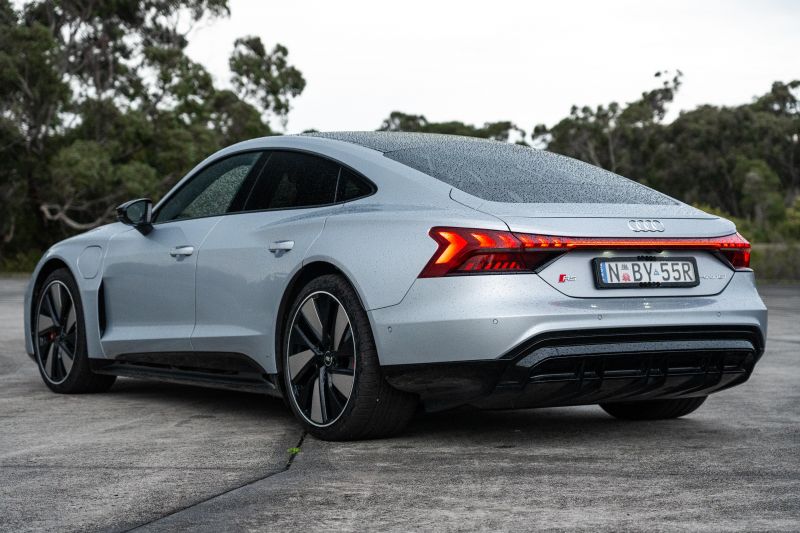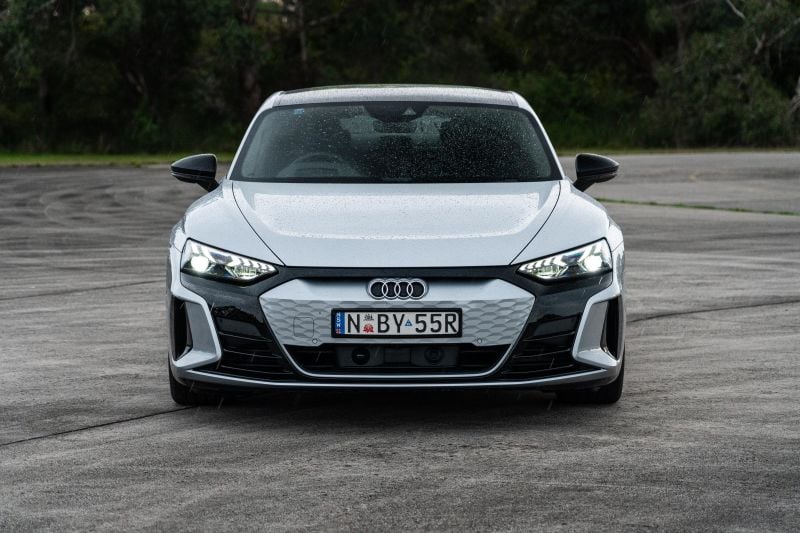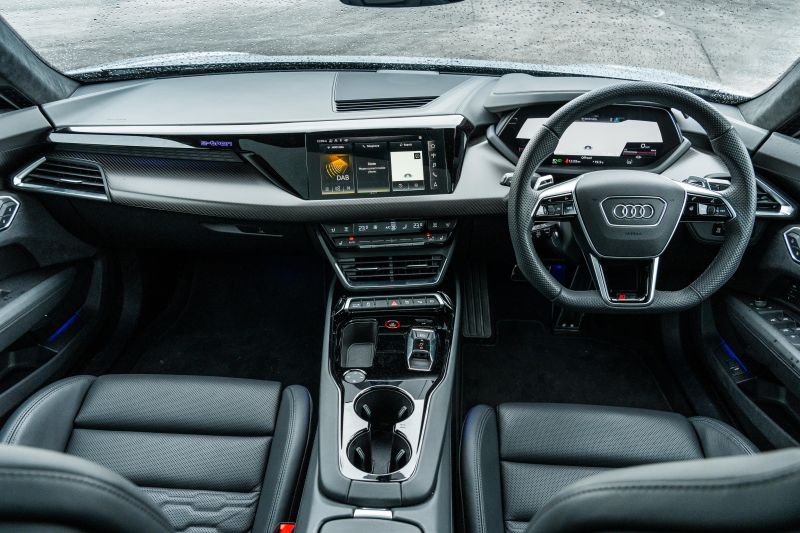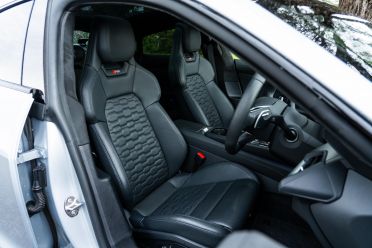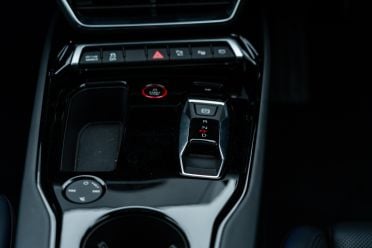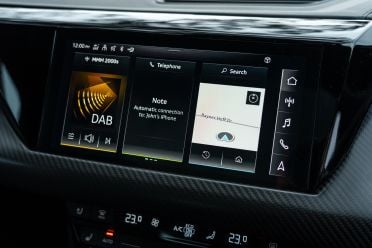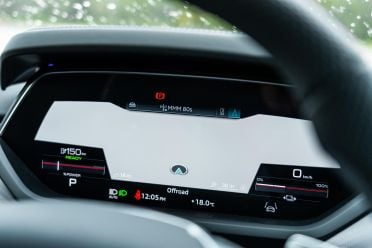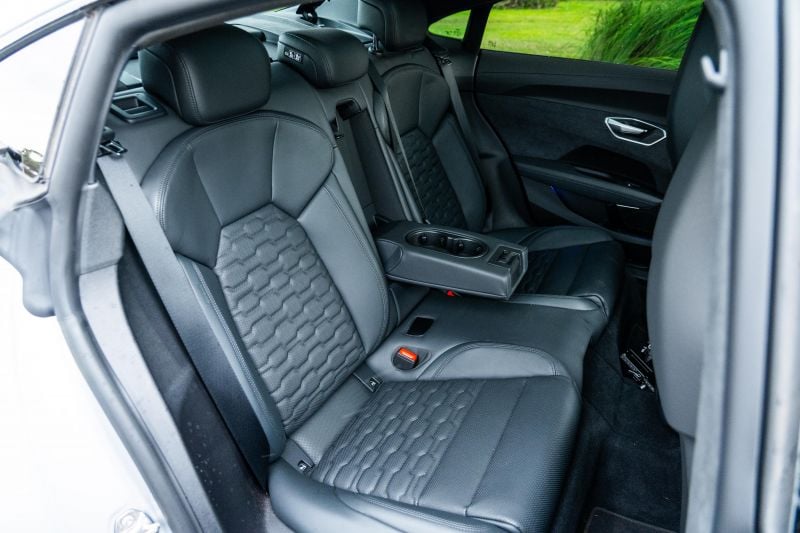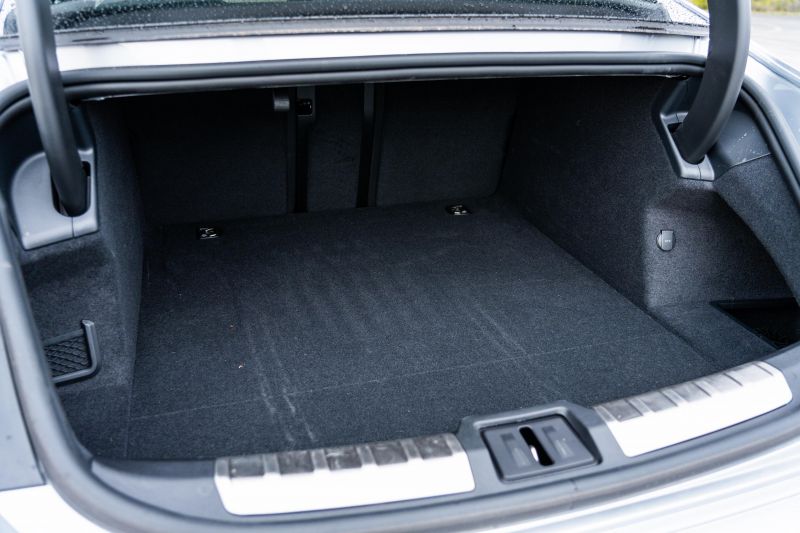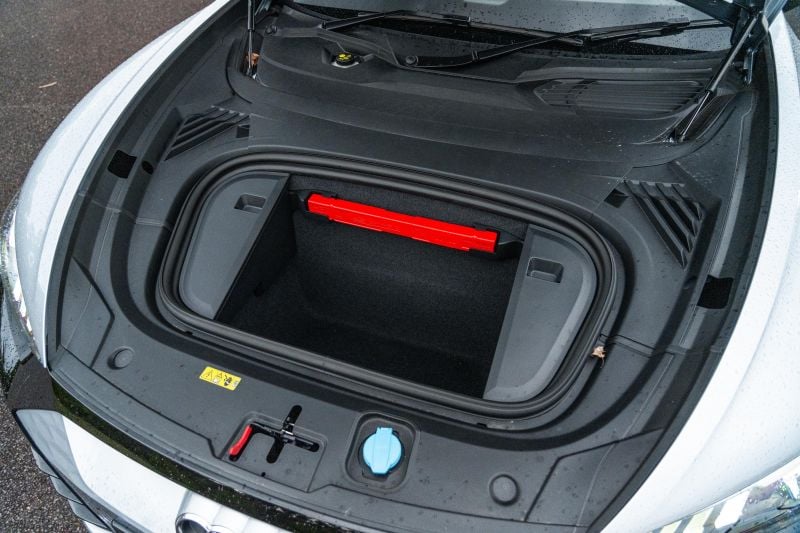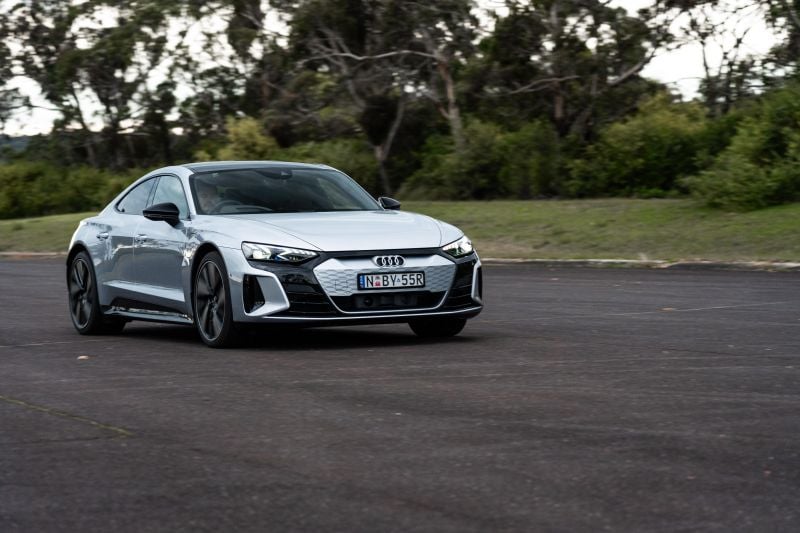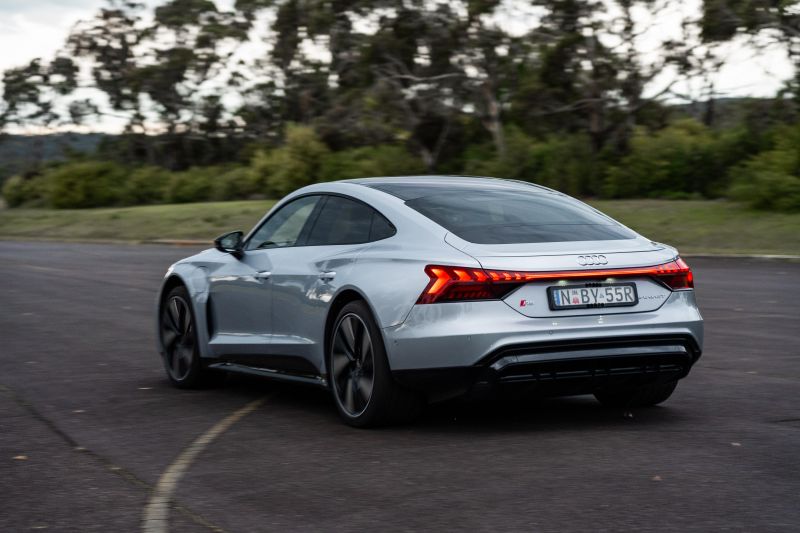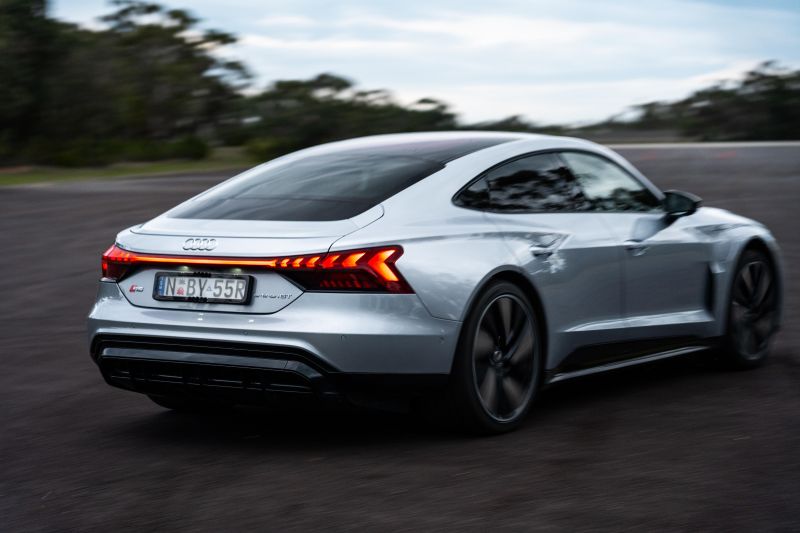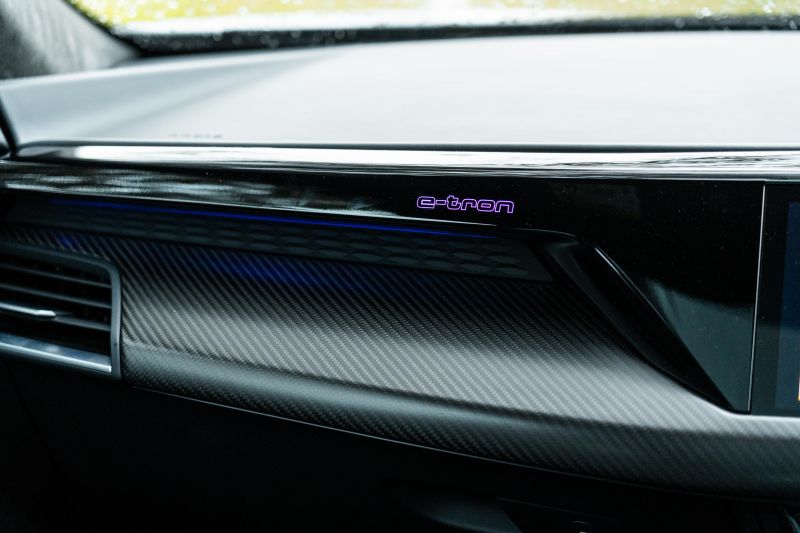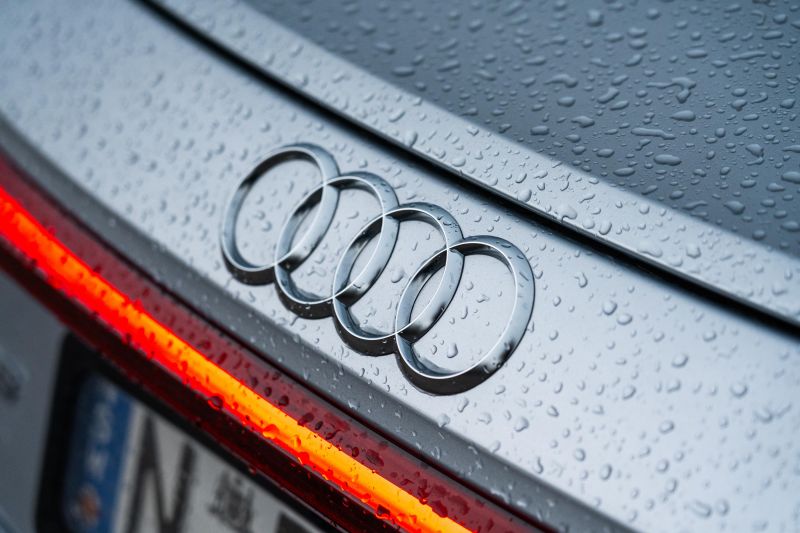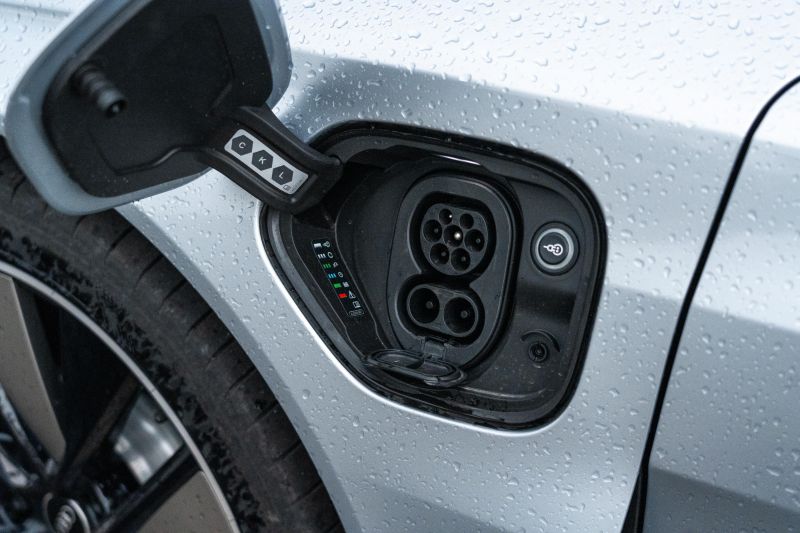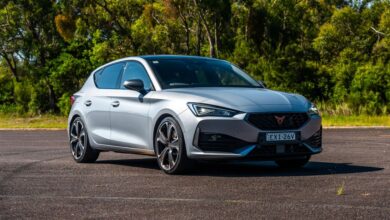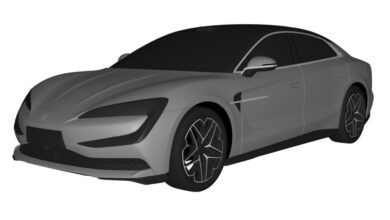2024 Audi RS e-tron GT review

There have been plenty of beautiful Audis throughout its history – the first A8 and TT come to mind, and of course there’s the R8.
The Audi e-tron GT though, might just be its best-looking vehicle yet. Low and sleek, with muscular haunches, the e-tron GT manages to be recognisable as an Audi without simply looking like an electric A7.
The only detail I don’t like on this stunning car is the integration of the sensors up front, though a facelifted model is coming. While we’re at it, this could do with some more distinctive colours – a deep green, a rich purple – than the silver and dark grey cars we drove.
Nevertheless, the car is gorgeous. But the e-tron GT is more than just a pretty face. With the R8 gone, it serves as the brand’s halo model, as well as – in RS guise – its performance flagship.
The RS e-tron GT is also the first RS-badged electric model from Audi. Sharing its J1 platform with the Porsche Taycan, it certainly has the mechanical aptitude to serve in this role.
So, what’s the 2024 Audi RS e-tron GT like?
How does the Audi e-tron GT compare?
View a detailed breakdown of the Audi e-tron GT against similarly sized vehicles.

Audi
e-tron GT
How much does the Audi e-tron GT cost?
There are two members of the e-tron GT range.
Our tester had various options included, with a before on-roads price of $246,875. Notably, the RS e-tron GT is extremely close in price to the twin-turbo V8-powered Audi RS7 Performance.
The RS e-tron GT is somewhere between the Porsche Taycan 4S and Taycan Turbo in both performance and price.
| Model Variant | $RRP |
|---|---|
| 2024 Audi e-tron GT | $183,900 |
| 2024 Audi RS e-tron GT | $252,600 |
Prices exclude on-road costs
To see how the e-tron GT shapes up against its rivals, use our comparison tool.
What is the Audi e-tron GT like on the inside?
You might look at this car and think inside will be cramped and uncomfortable, particularly in the back – you’d be wrong.
The issue with the RS e-tron GT’s cabin isn’t a lack of space, but rather the manner in which you access it. Those sleek lines compromise ingress and egress, and you step over wide sills and through somewhat small door openings to get in.
Once you’re in, the RS e-tron GT is surprisingly comfortable. Take the back seat for instance – at 180cm tall, I could comfortably sit up without my head touching the roof, while I could also sit behind my driving position without my knees touching the seats.
We probably wouldn’t want to sit in the centre seat for longer drives, but the cabin is certainly more comfortable than its styling would suggest.
After all, when a car looks like this and isn’t pitched as some kind of practical executive sedan, you expect some compromises. If you want more space, Audi’s upcoming A6 e-tron should fit the bill.
What I didn’t expect in the RS e-tron GT was an interior that didn’t feel like it belonged in a circa-$260,000 car.
It’s not that the interior feels cheap, it’s just that it doesn’t feel as expensive as its price tag would suggest.
The dark colourway of our tester doesn’t put its interior in the best light, but you can opt for much more appealing red, grey, and brown interiors. There’s still a lot of gloss black trim on the centre console though, regardless of the colour of the leather.
There have been some corners cut in the interior. The cowl over the instrument cluster is finished in hard plastic, even though the rest of the dash top is soft. So too are the rear door trims and the lower reaches of the front doors. Those rear doors also are quite light, and need a firm slam to close.
Those are minor gripes. What is less excusable is a persistent rattle emanating from the driver’s door, which could be heard not only on coarser-chip roads but even on city streets.
We also noticed a chirp from the driver’s side speaker during phone calls.
Shared switchgear and technology across a brand’s lineup is to be expected, but what may be impressive in a $36,200 A1 is less so at the other end of the price spectrum. And frankly, I don’t like Audi’s clackety drive mode selector button in an A1, so something this expensive deserves a nice knurled metal dial, or a steering wheel switch, or something.
There’s also a blank button on the centre console – I’m not sure what that’s supposed to be for, but it would annoy me if I was paying this much for a car.
Audi’s digital instrument cluster and infotainment system are also shared across a range of vehicles across the price spectrum, but they still stack up well at this price point.
The digital instrument cluster has multiple views, including a full-screen map mode, while the infotainment system has quick response times, modern graphics, and helpful anchored shortcut buttons to the side.
From a usability point of view, the RS e-tron GT’s plethora of buttons and physical switches is good. The centre stack is also helpfully angled towards the driver, and the standard Audi cruise control stalk is intuitive.
It’s let down a bit by the lack of storage up front – no sunglasses holder, only a small bin in the centre console and no storage underneath. Storage in the rear isn’t amazing either, with quite small bottle holders and no map pockets on the (rubberised) seatbacks.
The glass roof stops the cabin from feeling too gloomy – which would have been likely given the thin slit of rear window and the fairly high belt line.
There’s some subtle ambient lighting in the cabin, including on the softly padded sides of the centre console. Another neat design touch is the way the dashboard seems to wrap around to meet the door trims.
It may be a bit awkward stepping into the driver’s seat, but once you park there you’ll find it very comfortable. The seats are heavily bolstered and supportive, feature heating and ventilation, and the optional Sensory package brings myriad massage modes that work splendidly.
There are some quirks in the rear of the cabin. The two USB-C outlets are located not at the rear of the centre console, but in the front of the second-row seat base – very easy to miss. There are also air vents unusually situated on the floor, in addition to ones at the rear of the centre console.
The boot offers 350L of space, but the opening isn’t particularly large and the boot isn’t overly deep, even if it does extend back quite a bit. You’ll struggle to fit two suitcases back here.
There is under-bonnet storage up front, but you won’t fit more than a few grocery bags in there.
What’s under the bonnet?
There are two e-tron GT drivetrain variants on sale in Australia.
| Tech Specs | Audi RS e-tron GT |
|---|---|
| Power | 440kW – standard 475kW – boost mode |
| Torque | 830Nm |
| Driven wheels | All-wheel drive |
| Transmission | Two-speed |
| Battery | 93kWh lithium-ion |
| Claimed range | 471-480km (WLTP) |
| Energy consumption | 20.2kWh/100km (claimed) |
| Maximum AC charging rate | 11kW (22kW optional) |
| Maximum DC charging rate | 270kW |
| Charge time (5-80 per cent) | 23 minutes |
| 0-100km/h | 3.3 seconds (claimed) |
| Kerb weight | 2420kg |
To see how the e-tron GT shapes up against its rivals, use our comparison tool.
How does the Audi e-tron GT drive?
Unlock the vehicle and you’ll see some funky lighting animations front and rear. The tail light animation, in particular, gives Cylon-meets-Knight Rider vibes.
Open the door and step down into the heavily bolstered driver’s seat, and the vehicle will automatically turn on.
You can adjust its sound profile – there are three modes – and in its loudest mode there’s a subtle, almost rumbling idle sound.
Press the accelerator and there’s more to this quasi-combustion soundtrack. It’s hard to describe, but it’s reminiscent of various different petrol engines from the brand without being over the top.
You’ll also find this artificial sound can be heard from outside the vehicle, and it genuinely sounds cool. It’s nicer than the spooky ghost sounds a lot of other EVs make when you’re creeping through a carpark.
The sporty styling of the RS e-tron GT may suggest hardcore performance car, but this is really more of a grand tourer – albeit one that can truly rock you back in your seat.
You might expect the steering to have a fairly heavy weighting to it, but it doesn’t. It’s not too light, but there’s no way to add any artificial weight to it, and it never seems to have an abundance of feel. Brake pedal feel is also lacking.
Turn-in is sharp, though, and the RS comes standard with all-wheel steering. Utilising a spindle drive, the rear wheels can turn by a maximum of 2.8 degrees in the opposite direction to the front wheels at speeds of up to 50km/h for greater agility, or in the same direction above 80km/h for greater stability.
Grip is sensational in the RS e-tron GT, and it hunkers down in corners with no perceivable body roll. You can carry a lot of speed into corners, and the car feels extremely agile – particularly considering just how heavy it is! There’s also a bit of (controlled) oversteer in Dynamic mode.
The RS e-tron GT is also bloody fast. The official 0-100km/h claim is 3.3 seconds, but in Paul Maric’s instrumented testing the Audi did the dash in just 3.22.
It knocks you back in your seat whenever you floor it and takes the wind out of you. You can do a controlled launch by putting your feet on the brake and accelerator and pulling the right paddle.
Commuting to the office daily, the Audi proved eminently comfortable.
Much of the credit can go to the air suspension. The Audi always feels poised, yet it seems to glide over expansion joints and patchwork pavement in Comfort mode without ever feeling floaty. Even in Dynamic mode it’s still comfortable.
Get on the highway and the cabin is quiet, with virtually no wind noise and just the faint sound of the tyres. It would make quite a comfortable long-distance tourer, if only the range was higher – after all, there’s nothing luxurious about using Australia’s inadequate public charging infrastructure.
You can choose between Efficiency, Comfort, Dynamic and Individual drive modes, with the latter allowing you to tailor the drive system between Efficient, Balanced and Dynamic; the suspension between Comfortable and Dynamic; and the sound profile between Subdued, Balanced and Dynamic.
There’s no separate adjustment for steering, however.
While competing at a completely different (and considerably lower) price point, the Hyundai Ioniq 5 N has kind of spoiled me for other EVs with the level of adjustability it has, so the Audi’s Individual customisation seems a little sparse.
There’s also no one-pedal drive mode. You can adjust the level of regenerative braking, however, but there’s no mode that allows the vehicle to come to a complete stop when you let off the accelerator pedal.
Oddly, I couldn’t find a way to display the battery percentage in the instrument cluster, though you can find it in the Charging menu on the touchscreen. There’s also no traffic sign readout in the cluster.
There’s an auto hold mode, allowing the vehicle to stay put once you have come to a complete stop without having to put it in Park, but you’ll need to firmly press the brake pedal to activate this.
The lane assists didn’t work perfectly, a couple of times chiding me to take control when I never relinquished it. Nevertheless, the system works pretty well at keeping you centred within your lane.
Parking is a bit of a chore, even if the all-wheel steering does tighten the turning circle by 0.6m.
While camera resolution is sharp and there’s a 3D mode, the reversing camera has a rather distorted view. The vehicle also has extremely wide hips and a mail slot for a rear window, and to complicate things further its parking sensors are over-sensitive.
Over the course of a week with the car and over 600km of driving, we saw energy consumption of 22.9kWh/100km, while on a loop comprising a mix of inner-city, suburban and highway driving we used 19.6kWh/100km. The official claim is 20.2kWh/100km.
Those figures don’t sound all that impressive, considering we’ve gotten better energy efficiency out of large (if less powerful) electric SUVs. And while I certainly did a few controlled launches, a lot of my time with the RS e-tron GT was spent commuting.
One odd thing to note: the little cutouts on the front fenders, presumably designed to aid airflow, managed to get filled with leaves.
What do you get?
The RS e-tron GT builds on the standard e-tron GT with more performance hardware, as well as some additional luxury features.
e-tron GT standard equipment:
- 20-inch alloy wheels
- Tyre repair kit
- Adaptive air suspension
- Fixed glass roof
- HD matrix LED headlights
- Audi laser light
- Positioning, cornering lights
- Automatic headlights
- Rain-sensing wipers
- Hands-free power boot lid
- 10.1-inch touchscreen infotainment system
- Satellite navigation
- Wireless Apple CarPlay, Android Auto
- 12.3-inch digital instrument cluster
- Wireless phone charger
- 16-speaker Bang & Olufsen 3D sound system
- DAB+ digital radio
- Head-up display
- Leather upholstery
- Power-adjustable front seats
- Heated front seats
- Leatherette trim for centre console, upper dashboard, doors
- Graphite grey inlays
- Aluminium sill plates
- Leather-wrapped steering wheel
- Tri-zone climate control
- Ambient lighting
RS e-tron GT adds:
- 21-inch alloy wheels
- All-wheel steering
- Electronically controlled fully variable rear-axle differential lock
- RS e-tron “sport sound”
- Rear privacy glass
- Nappa leather upholstery
- Ventilated front seats
- Heated steering wheel
- Dinamica and Nappa leather trim for dashboard, lower interior elements
- Carbon twill matte inlays
- Colour-adjustable ambient lighting
- Stainless steel pedals
Some – but not all – of the RS’ features can be added to the base e-tron GT via option packages. The RS can be had with additional option packages.
The carbon and black exterior styling package costs $15,000 and includes:
- Carbon roof (replaces glass roof)
- Front side air intakes, inlays in door trim strips and rear diffuser insert in carbon
- Carbon exterior mirror caps
- Black badges
The Sensory package ($8400) adds:
- Massaging front seats
- Heated outboard rear seats
- Air quality package with ioniser
- Illuminated sill plates with carbon inlay
- Black Dinamica headliner
The red/grey RS design package ($4550) includes:
- Alcantara-wrapped steering wheel (without heating)
- Nappa leather upper dash, centre console and armrests
- Express red or grey stitching elements
- Centre console surround, door inserts and instrument panel cover in black Dinamica
- Red or grey seatbelts
- Black floor mats
Our tester included the Sensory package, plus 22kW AC charging ($6900), gloss black badging (an extra $700), and different 21-inch alloy wheels (an extra $1800).
Is the Audi e-tron GT safe?
The Audi e-tron GT has yet to be tested by ANCAP or Euro NCAP.
Standard safety equipment includes:
- Autonomous emergency braking
- Pedestrian detection (up to 85km/h)
- Vehicle detection (up to 250km/h)
- Cyclist detection (from 5km/h)
- Junction assist
- Adaptive cruise control with stop/go
- Blind-spot monitoring
- Lane keep assist
- Rear cross-traffic alert
- Safe exit warning
- Surround-view camera
- Front and rear parking sensors
- Front, side and curtain airbags
How much does the Audi RS e-tron GT cost to run?
Like the wider Audi range, the e-tron GT is covered by a five-year, unlimited-kilometre new vehicle warranty.
Audi also covers the high-voltage battery of e-tron models for eight years or 160,000km – whichever comes first.
You get six years of free scheduled servicing, as well as six years of roadside assistance and six years of complimentary charging through the Chargefox network.
CarExpert’s Take on the Audi RS e-tron GT
The Audi RS e-tron GT is more than just a pretty face – and in some ways, it actually really surprised me.
It has the 0-100km/h time of a hardcore performance car, though its steering and brakes feel more like those of a luxury sedan. Fortunately for the Audi, it also has the ride comfort of a luxury sedan thanks to that splendid air suspension.
The cabin I thought would be cramped ended up being comfortable, if a bit difficult to wedge oneself into.
It also proved a comfortable commuter, with the party trick of acceleration that will startle your passengers, and yet it was surprisingly nimble on a winding road despite its heavy kerb weight.
It’s not perfect. Besides the poor visibility and ingress – a result of that sexy, sexy body – there’s also high energy consumption and an interior that really should be nicer at this price point.
But wow, just look at the thing. If the price tag is too high, Audi will also sell you a regular e-tron GT that foregoes some of the performance hardware and a little bit of power and torque but looks just as stunning.
There are two things to consider before parting with your hard-earned quarter of a million-plus dollars. Audi has been spied testing an updated e-tron GT, and Porsche has already updated the related Taycan with more power and quicker charge times.
There may be an increasing number of luxury EVs, but the RS e-tron GT and Taycan don’t have much in the way of direct competition, being sleeker and more performance-focused than similarly sized vehicles from BMW and Mercedes-Benz.
Their own worst enemies are each other, and we’d strongly suggest you check out the Taycan as well before signing on the dotted line of the (arguably more beautiful) Audi.
Click the images for the full gallery
MORE: Buy an Audi e-tron GT
MORE: Everything Audi e-tron GT
